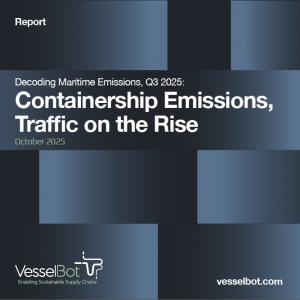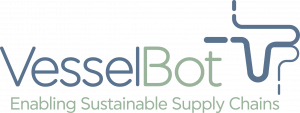Containership Emissions and Traffic on the Rise as Industry Navigates Regulatory Crossroads
VesselBot's Q3 2025 report "Decoding Maritime Emissions: Containership Emissions and Traffic on the Rise," delivers unique insights into maritime operations
ATHENS, GREECE, November 5, 2025 /EINPresswire.com/ -- In its latest quarterly analysis titled "Decoding Maritime Emissions, Q3 2025: Containership Emissions and Traffic on the Rise," VesselBot delivers comprehensive insights into maritime operations during a period of heightened regulatory uncertainty and persistent trade disruptions. This detailed study analyses 73,353 containership voyages completed by 4,750 vessels between July and September 2025, revealing critical patterns in containerships fleet performance as the industry approaches crucial compliance deadlines.
Using enriched primary data captured at the vessel and voyage level, the report examines maritime performance across multiple dimensions - vessel size, age, shipbuilding origin, and specific trade routes - providing stakeholders with the granular analysis necessary for informed decision-making in an increasingly complex operational environment.
Key findings from VesselBot's vessel-level monitoring and analysis reveal:
Emissions Stabilization Amid Traffic Growth: Total containership emissions reached 50.3 million tons in Q3 2025, remaining virtually unchanged (-0.2%) compared to Q3 2024 despite a 2.3% increase in voyages. Average well-to-wake emissions intensity improved to 195.9 g CO2e/TEU km, down 1.6% year-over-year, driven by longer steaming times and reduced port dwell times.
Trade Tensions Reshape Routing: Direct China-U.S. voyages showed pronounced volatility, declining 3% in the first nine months of 2025 but spiking 15% in July before dropping 10% in September. China's retaliatory port fees targeting U.S.-owned, operated, or built vessels introduce additional complexity to carrier deployment strategies.
Persistent Vessel Size Efficiency Gaps: Well-to-wake emissions intensity varies dramatically by vessel size, from 252.1 g CO2e/TEU km for Feeder vessels (up to 2,999 TEU capacity) to 61.4 for Very Large Container Ships (at least 17,000 TEU capacity). Feeder vessels completed 62.1% of all Q3 voyages yet accounted for only 10.3% of total TEU km, while VLCS completed just 2% of voyages, accounting for 17.2% of total TEU km, which reflects their significantly higher efficiency levels.
Shipbuilding Origin Influences Deployment: Chinese-built vessels completed 36% of Q3 voyages, while 53.1% of vessels under 5 years old have been built from Chinese shipyards. South Korean-built vessels carried out 24.6% of all Q3 containership voyages, but 41.3% of all VLCS. South Korean built vessels' voyages recorded the lowest emissions intensity at 152.7 g CO2e/TEU km due to larger capacities and long-haul trade deployment.
Route-Specific Performance Variations: Major fronthaul trades demonstrate the importance of route-level analysis, with Asia-Northern Europe voyages averaging an intensity of 55.3 g CO2e/TEU km and a duration of 30.6 days In contrast, industry-wide average steaming time was only 3.5 days, highlighting how aggregate metrics obscure critical operational differences.
"The regulatory landscape is growing more complex rather than simplified, as evidenced by the European Parliament rejection of the Omnibus simplification effort and the IMO's postponement of the Net-Zero Framework," noted C. Komodromos, CEO & Founder of VesselBot. "With CBAM certification requirements beginning in weeks and Scope 3 reporting deadlines approaching, maritime stakeholders require granular, real-time data to navigate diverging compliance requirements across multiple jurisdictions. Industry averages fail to capture the significant performance variations between vessel sizes, ages, and routes that directly impact both compliance costs and operational efficiency. VesselBot's voyage-level analysis reveals that containership intensity can vary significantly depending on vessel characteristics; insights that are invisible in aggregated data but critical for strategic decision-making in an increasingly carbon-constrained environment."
The report provides detailed analysis of fleet dynamics, regulatory developments including the delayed IMO framework, stalled EU simplification efforts, and approaching compliance deadlines, vessel age and shipbuilding country performance comparisons, and emissions patterns across specific trade routes - equipping maritime stakeholders with the actionable intelligence needed to navigate 2026's regulatory implementation phase.
The complete report is available here.
VesselBot invites media inquiries and is available for interviews to discuss the report's findings.
Maria Bena
VesselBot
+30 21 1117 8743
email us here
Visit us on social media:
LinkedIn
Facebook
X
Legal Disclaimer:
EIN Presswire provides this news content "as is" without warranty of any kind. We do not accept any responsibility or liability for the accuracy, content, images, videos, licenses, completeness, legality, or reliability of the information contained in this article. If you have any complaints or copyright issues related to this article, kindly contact the author above.


